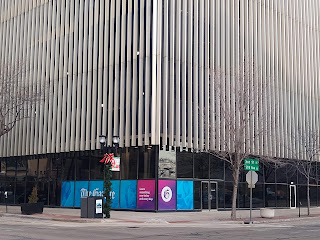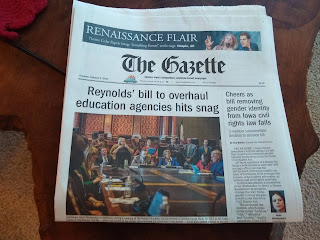 |
(L to R) Jennifer Pratt, Pat Parsley, Kim Downs, Drew Retz
|
My friend Eric Gutschmidt is fond of saying "You can't build a $100,000 house." That unpleasant reality underlay the lively discussion of housing issues Tuesday morning at the Gazette Business Breakfast in the Geonetric Building cafeteria. Various subjects fell into three major topic areas: supply, price, and neighborhood context.
Supply
Kim Downs, deputy city manager for the City of Marion, described slow progress on a variety of housing needs. She cited a need for multi- and single family housing at all price points, a need echoed by the other panelists. Pat Parsley, community development director for the City of Hiawatha, cited a 2020 housing study showing a particular shortage of rental housing, which has spurred development of 200 units built since then.
All three towns are actively building, with the assistance of Community Development Block Grant (CDBG) funding as well as derecho recovery funds. Jennifer Pratt, community development director for the City of Cedar Rapids, reported five multifamily units underway, and previewed a program ("Roots 2.0") that will build 76 houses in the 2008 flood zone that will sell for $175,000; she also noted "growth corridors" in the northeast quadrant (mostly single-family) and to the south near the College Community School District megacampus. Hiawatha touted their first multifamily development in ten years and first senior living facility ever, to be located in their emerging Boyson Road complex. Marion mentioned the rehabilitation of the former First United Methodist Church downtown as well as an "aging-in-place" development east of Route 13 with options for all ages.
An audience member asked about the demand for all this new housing. Unfortunately, she drowned her own question in a sea of unrelated issues, so it never got properly answered. What is the occupancy rate of recently-constructed apartments? What is the evidence (besides the existence of regular housing surveys) that we are under-supplied? Drew Retz, vice president of Jerry's Homes, said that he knew anecdotally that some of their customers have moved from out of state to take jobs, and that their houses were occupied upon construction.
Price
Only two factors in housing inflation were considered: high interest rates and regulatory compliance costs. The Federal Reserve Board is maintaining the prime lending rate, from which all other interest rates derive, at a historically high 5.25-5.5 percent, at least for now (Lee and Heuer 2024). Rates were raised to combat inflation resulting from coronavirus pandemic disruptions to the economy, and thus represent a temporary if powerful factor in raising housing prices. Kim Downs said interest rates were driving potential homebuyers into the rental market, and inspiring homeowners to convert all or part of their houses to rent. To me that suggests these individuals are deferring their long-term purchases, rather than buying a smaller cheaper house now. When they come back into the market in the next few years, that will have an interesting effect on demand and hence on prices.
Drew Retz cited an estimate, which no one contradicted, that 25 percent of the cost of new housing is due to government regulation, and that it thereby takes about 18 months to build anything, implying (probably accurately) that price reduction was within the power of the cities, should they choose to use it. The city people all said they were working on streamlining the approval process to make it faster and more predictable, but even Pat Parsley from "developer friendly" Hiawatha allowed they also had a duty to the public to make sure the streets, trees, and such were done for the benefit of the public. (Streets "wide enough?" If developers want to build 16 foot streets, let 'em, I say.)
Retz made another point that's worth considering; Houses are built and sold by private businesses that need/expect a return on their investment, one that exceeds the return on financial instruments that don't require strenuous physical work. If buyers expect "everything," and cities are both willing to add to the cost with regulation and to subsidize some of the cost with public funds, what winds up being the right price? We seem to have lost the market price signals that could answer that question. Why wouldn't I want a big house with a big yard on a wide tree-lined street, a street that is plowed quickly after a snowstorm, located at an insulating distance from the madding crowd, yet near enough to parks and schools, if I didn't recognize that all of these have costs that must be borne by someone if not me? That's what my parents had!
We have difficulty, in both the private and public realms, talking about who pays for social costs not borne by the buyer or seller (known in the biz as "market failures"). Spreading out as we have done for two or three generations creates financial burdens for communities as well as environmental strains and all the problems attendant to car dependency. More demand raises the price of anything--that's simple economics, but problematic if we also consider a good like housing to be a necessary human right. These are awkward and unpleasant subjects to be broached in most spaces, and they were not broached on Tuesday.
Neighborhood Context
Social subjects did sneak in when the panel discussed "neighborhoods." Jennifer Pratt said Cedar Rapids is looking for "complete neighborhoods" as described in the 2015 plan EnvisionCR and subsequent updates. The adjective "healthy" was also used with respect to this, leading an audience member to ask what was meant by a healthy neighborhood. Pat Parsley defined it as a diversity of housing options, mixing uses within a walkable area (a radius of about one mile); such nodes are being built in his town of Hiawatha. Jennifer Pratt added that the cities also need to be mindful of what the market is looking for, which might include single use subdivisions.
Dorothy DeSouza Guedes of the Oak Hill Jackson Neighborhood Association, which has seen a great deal of development since the 2008 flood wiped out a huge swath of it, asked if current residents could be engaged earlier in the development process. Consultation with the neighborhood is required by law, but large developers in particular have the reputation of doing the minimum so late that it's ineffective. Yet residents have reputations, too. They surely have an essential voice in development of their own neighborhood, but too often they have exercised or tried to exercise veto power over beneficial development.
Neighborhood, in other words, is a slippery concept. I have no problem with people living in whatever type of neighborhood they wish, as long as they're willing to pay the social costs, and as long as there's room left for everybody else to live as well. This is maybe a more difficult discussion than we were ready for Tuesday.
The Gazette Business Breakfast series next moves to Iowa City in April for a discussion of state and local taxes.
SEE ALSO: "New Data on Housing Prices," 23 January 2024








